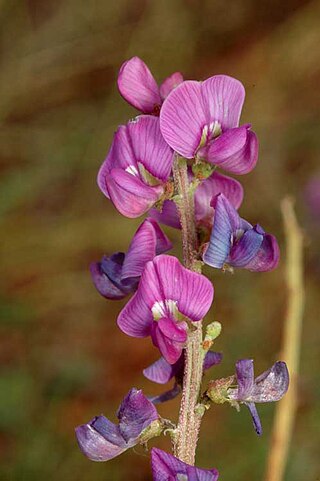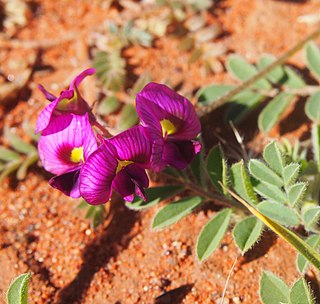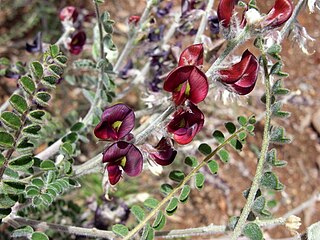
Swainsona greyana, commonly known as the Darling pea or hairy-Darling pea, is a species of flowering plant in the family Fabaceae and is endemic to south-eastern continental Australia. It is an erect perennial subshrub with imparipinnate leaves with 17 to 21 egg-shaped leaflets, and racemes of 12 to 20 or more white, pink or purple flowers.

Swainsona behriana, commonly known as Behr's swainsona, is a species of flowering plant in the family Fabaceae and is endemic to south-eastern continental Australia. It is a prostrate or low-growing perennial herb with imparipinnate leaves usually with 9 to 13 narrowly elliptic to egg-shaped leaflets with the narrower end towards the base, and racemes of 2 to 7 purple flowers.
Swainsona acuticarinata is a species of flowering plant in the family Fabaceae and is endemic to arid areas of central Australia. It is a prostrate perennial herb with imparipinnate leaves with 5 to 11 leaflets, and racemes of purple flowers.

Swainsona affinis, commonly known as common poison pea, is a species of flowering plant in the family Fabaceae and is endemic to arid areas of inland Australia. It is a prostrate perennial herb with imparipinnate leaves with 7 to 25 broadly elliptic leaflets, and racemes of purple, pink, yellow or white flowers.

Swainsona beasleyana is a species of flowering plant in the family Fabaceae and is endemic to inland areas of Western Australia. It is a low-lying perennial herb with imparipinnate leaves usually with 15 to 19 egg-shaped leaflets with the narrower end towards the base, and racemes of 3 to 8 pale or dark purple flowers.

Swainsona brachycarpa, commonly known as slender swainson-pea, is a species of flowering plant in the family Fabaceae and is endemic to eastern Australia. It is a prostrate or ascending perennial herb with imparipinnate leaves usually with 9 to 13 egg-shaped to narrowly elliptic or egg-shaped leaflets, and racemes of up to 12 white, purple or dark red flowers.
Swainsona bracteata is a species of flowering plant in the family Fabaceae and is endemic to eastern Australia. It is a perennial herb with imparipinnate leaves usually with 19 to 25 narrowly egg-shaped leaflets, and racemes of about 20 white, pale pink or pale purple flowers.

Swainsona burkei is a species of flowering plant in the family Fabaceae and is endemic to northern Australia. It is a prostrate or perennial subshrub with imparipinnate leaves usually with 5 to 11 oblong to narrowly egg-shaped leaflets, and racemes of 5 to 10 purple flowers.

Swainsona burkittii, commonly known as woolly Darling pea, is a species of flowering plant in the family Fabaceae and is endemic to inland Australia. It is an erect or low-lying perennial with imparipinnate leaves usually with 15 to 30 egg-shaped to more or less circular leaflets, and racemes of up to fifty dark reddish-purple flowers.
Swainsona cadellii is a species of flowering plant in the family Fabaceae and is endemic to inland New South Wales. It is a shrubby perennial with imparipinnate leaves usually with 5 to 15 mostly narrowly egg-shaped leaflets, and racemes of 15 to 20 white, pink or purple flowers.
Swainsona calcicola is a species of flowering plant in the family Fabaceae and is endemic to north-western Western Australia. It is a prostrate or ascending, low-growing perennial with many stems, imparipinnate leaves usually with 7 to 11 broadly egg-shaped leaflets with the narrower end towards the base, and racemes of usually 4 or 5 pink, purple or red flowers.

Swainsona campestris is a species of flowering plant in the family Fabaceae and is endemic to arid areas of southern Australia. It is an erect perennial herb with imparipinnate leaves with 9 to 11 linear to narrowly lance-shaped leaflets, and racemes of pink or purple flowers in racemes of 5 to 10.

Swainsona campylantha, commonly known as Gilgai Darling pea, is a species of flowering plant in the family Fabaceae and is endemic to inland areas of Australia. It is a low-growing perennial with imparipinnate leaves usually with up to 7 narrowly lance-shaped to narrowly elliptic leaflets, and racemes of 2 to 10 pink to purple flowers.
Swainsona cornuta is a species of flowering plant in the family Fabaceae and is endemic to the west of Western Australia. It is a low-lying, annual or perennial herb with imparipinnate leaves usually with about 7 elliptic leaflets and racemes of 3 to 7 purple flowers.
Swainsona dictyocarpa is a species of flowering plant in the family Fabaceae and is endemic to central areas of South Australia. It is a small erect perennial herb with imparipinnate leaves with 3 to 7 elliptic leaflets, and racemes of purple flowers in racemes of 2 to 6.
Swainsona disjuncta is a species of flowering plant in the family Fabaceae and is endemic to widely separated areas of central Australia. It is a prostrate perennial herb with imparipinnate leaves with 3 to 9 egg-shaped leaflets, and racemes of purple, pink or red flowers in racemes of 3 to 15.
Swainsona fissimontana is a species of flowering plant in the family Fabaceae and is endemic to inland areas of southern continental Australia. It is a compact, erect or upright perennial herb with imparipinnate leaves with 7 to 13 narrowly elliptic to elliptic leaflets, and racemes of pink to dark purplish flowers in racemes of 3 to 11.
Swainsona forrestii is a species of flowering plant in the family Fabaceae and is endemic to the central northern Western Australia. It is an erect or spreading, single-stemmed annual herb, with imparipinnate leaves with about 13 to 17 narrowly egg-shaped or narrowly ellipitic leaflets, and racemes of dark brownish red to purple or pink flowers in racemes of 30 or more.
Swainsona fuscoviridis is a species of flowering plant in the family Fabaceae and is endemic to South Australia. It is a perennial plant with many stems and imparipinnate leaves with mostly 7 or 9 ellipitic, linear or egg-shaped or lance-shaped leaflets, and racemes of 12 to 20 purple flowers.
Swainsona gracilis is a species of flowering plant in the family Fabaceae and is endemic to the south-west of Western Australia. It is a prostrate or ascending perennial herb with imparipinnate leaves with up to 15 wedge-shaped or narrowly oblong leaflets, and racemes of up to 4 purple or blue flowers.









